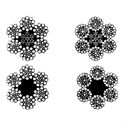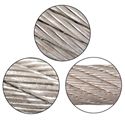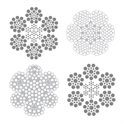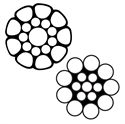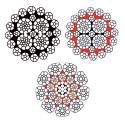Wire Ropes
Wire rope consists of three basic components; while few in number, these vary in both complexity and configuration to produce ropes for specific purposes or characteristics. The three basic components of a standard wire rope design are: 1) wires that form the strand, 2) multi-wire strands laid helically around a core, and 3) the core.
Wire, for rope, is made in several materials and types; these include steel, iron, & stainless steel to name a few. By far, the most widely used material is high carbon steel. This is available in a variety of grades each of which has properties related to the basic curve for steel wire rope. Wire rope manufacturers select the wire type that is most appropriate for the requirement of the finished product.
Different grades of wire rope are available such as: improved plow steel (IPS), extra improved plow steel (EIPS), and extra extra improved plow steel (EEIPS). The plow steel curve forms the basis for calculating the strength of most steel rope wires, the tensile strenght (psi) of any steel wire grade is not constant, it varies with the diameter and is highest in the smallest wires.
The most common finish for wire rope is "bright" or uncoated. Steel wires may also be metallic coated with zinc (galvanized) or zinc/aluminum alloy (mischmetal). "Drawn galvanized" wire has the same strength as bright wire, but wire "galvanized at finished size" is usually 10% lower in strength. For other applications, different coatings are available.
"Iron" type wire is actually drawn from low-carbon steel and has a fairly limited use except in elevator installations.
Stainless steel wire rope, listed in order of frequency of use, are mode of AISI types 302/304, 316, and 305. Contrary to general belief, hard-drawn stainless type 302/304 is magnetic. Type 316 is less magnetic, and type 305 has a permeability low enough to qualify as non-magnetic.
Strands consists of two or more wires, laid in any one of many specific geometric arrangements, or in a combination of steel wires with some other materials such as natural or synthetic fibers. It is conceivable that a strand can be made up of any number of wires, or that a rope can have ay number of strands.
The core is the foundation of a wire rope; it is made of materials that will provide proper support for the strands under normal bending and loading conditions. Core materials include fibers (natural or synthetic) or steel. A steel core consists either of a astrand or an independent wire rope. The three most commonly used core designations are: fiber core (FC), independent wire rope core (IWRC), wire strand core (WSC), and wireline.
Mobile Load Testing Services & Inspections
Horizon Cable Service also offers inspections and mobile proof test services for product verification, break testing and load testing to ensure compliance for all wire ropes we sell and repair. Our mobile proof test services are available throughout the United States. In addition to our mobile load testing services we have stationary beds to service Oklahoma, Texas, North Dakota, Wyoming, Kansas, New Mexico and all surrounding areas. Feel free to contact one of our industry professionals today at 866-369-9507.


